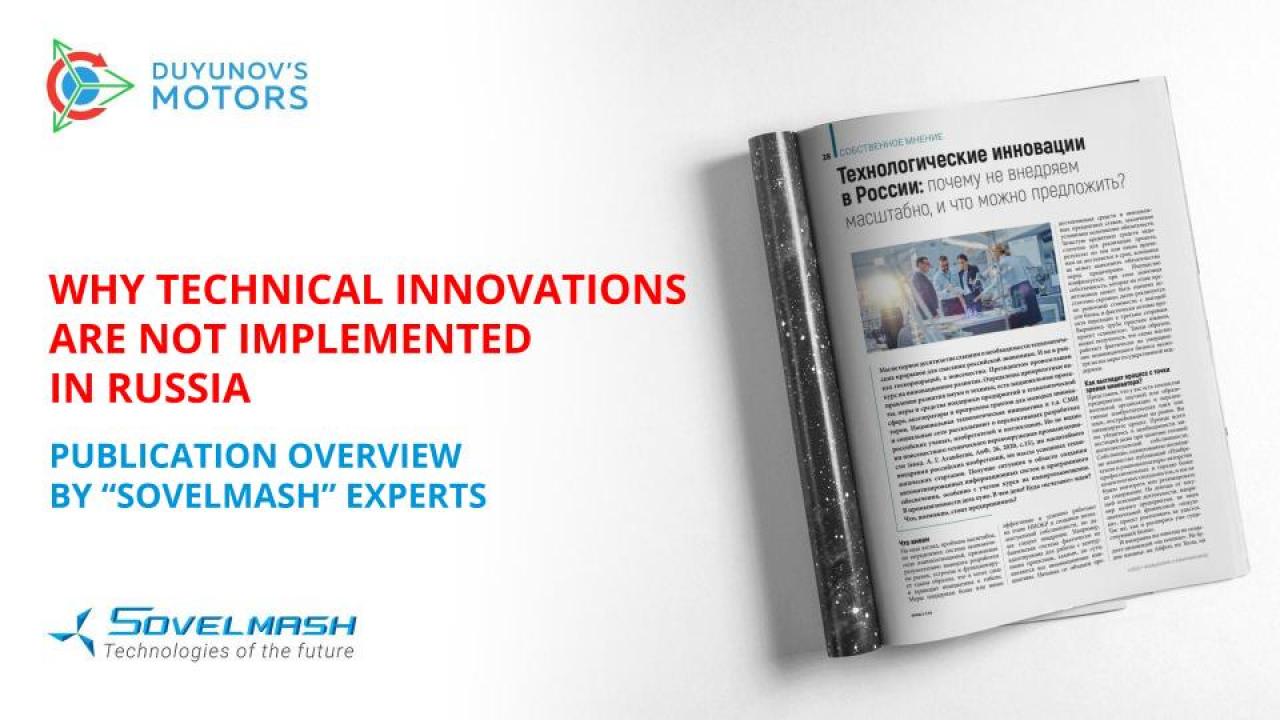
Why technical innovations are not implemented in Russia on a large scale: a publication overview by "SovElMash" experts
Many investors of the project "Duyunov 's motors" are interested in what lies in store for innovations in Russia where it is very rare for an invention to reach the stage of full implementation. Why do very few innovative enterprises manage to "survive" and what important advantage does our project have? This urgent issue was addressed in an article by Yana Teplova and Yuriy Agrikov, the members of "SovElMash" team, published in the latest issue of the popular science journal "Inventor and Rationalizer" (№ 4, 2020), in the "Personal Opinion" section.
The authors are interested in why technical innovations are not implemented on a large scale in Russia, despite the fact that the country's authorities have declared a focus on innovative development and there are a number of grant schemes to support science and technology.
The reason why a lot of initiatives fail, according to the authors of the article, is the economic system itself, which is entitled to develop them.
"The banking system is not actually adapted to work with venture projects, which, in fact, all innovative initiatives are. Starting from the amount of funds provided and unaffordable interest rates, and ending with the terms of performance of obligations. Interest rates are commonly not enough for the project implementation, the result is not achieved on time for one reason or another, the company cannot fulfill its obligations to the creditors... the system is virtually tailored to kill innovative businesses, despite all the measures of state support."
Banks definitely benefit from businesses going bankrupt: property that was modestly assessed at the lending stage is confiscated and sold at the market value, then all the assets go to third parties.
At the same time, we must understand that it is not about the inability of innovators to manage their own and attracted resources. Innovative projects are always risky by definition. Their full implementation requires a solid financial security cushion and considerable time. In the modern world, there are no "quick-and-dirty" innovations made using whatever was available "in a garage". What resources are needed to transform an idea or patent into a finished product?
Labour. This is the work of researchers, engineers, process engineers, design engineers, shop floor workers, programmers, analysts, economists, etc.
Logistics and inventory: equipment, materials, software.
Third-party services: from leasing premises to certification services.
The success of the invention implementation may be affected by external factors: sanctions, competition, the presence of a strong monopoly on the market, and others. The probability of not meeting deadlines and not fulfilling obligations is high. Innovative activities supported by grants are impeded by a variety of inspections, approvals and reports that can even scare off potential customers.
A good example of an innovative initiative that has fallen victim to the system is the Zetta project. The electric car developers did not have enough funds to start the pilot scale assembly, and the next loan application was rejected due to the riskiness of the enterprise. Circumstances were also adverse: the dollar exchange rate surged, and the pandemic stopped the supply of foreign component parts. As a result, the company is now trying to earn money on engineering services to complete the project.
Is there a way out for innovative enterprises in Russia, or is it deadlock? The authors of the article believe that one of the ways of solving the problem can be crowdinvesting. Crowd funding allows innovators to stay immune to enslaving conditions, and investors - to return their investments when the project targets are achieved and own part of the company's assets.
"In the market of different investment lines, crowdinvesting is taking an increasingly strong position due to the powerful opportunities for interaction between a large number of investors and projects without any intermediaries...". Companies that implement crowdinvesting projects are directly responsible to their investors. And many people have the opportunity to participate in the development of innovations and create their own investment portfolios on affordable terms to make profit in the future. And although each party bears certain risks, "the model of a crowd, "distributed" investor without an intermediary is likely to significantly compensate for at least the risk of underfunding."
You can read the full article here - https://clck.ru/SNxEG
Crowdinvesting projects that are gaining popularity in the world are still rare in the Russian reality. The project "Duyunov's motors" is unique for Russia in many respects, because it does not follow the well-trodden path, but is rather blazing a trail. And, perhaps, later some other domestic innovators will walk this path.

